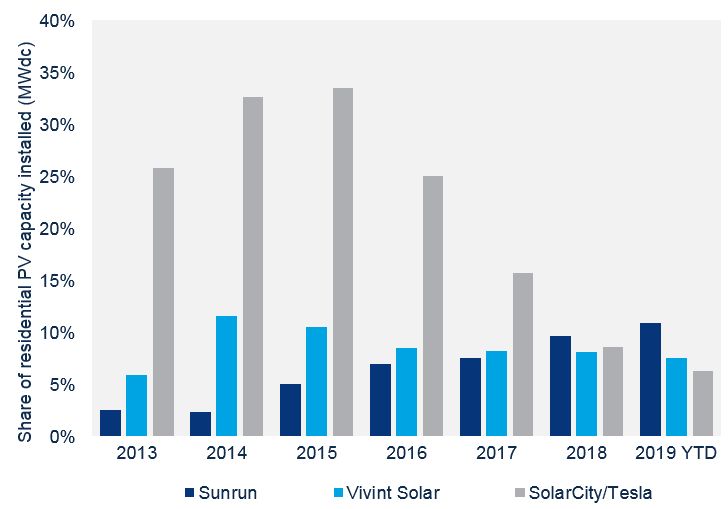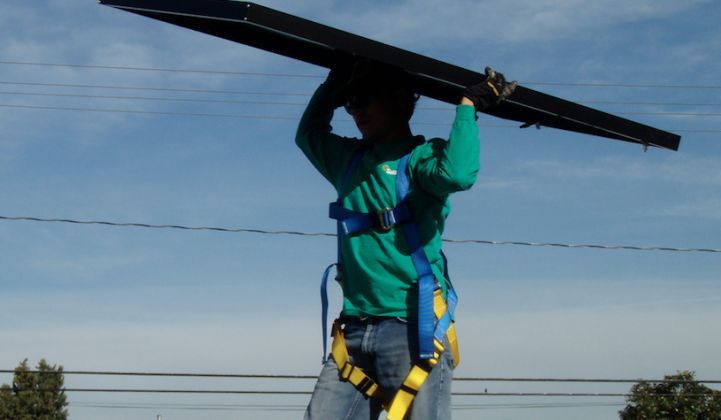Tesla sank to third place among U.S. residential solar providers for installations in the first quarter of 2019, continuing the one-time market leader's dramatic decline.
The latest ranking from Wood Mackenzie Power & Renewables shows Vivint Solar knocking Tesla out of second place. Sunrun’s direct solar business pulled ahead of Tesla in the second half of 2018.
That's not to say that Vivint gained market share at Tesla's expense. Vivint’s percentage of the market actually shrank, from a high of 11.6 percent in 2014 to 7.3 percent so far in 2019.
Those figures underscore the magnitude of Tesla’s even more dramatic decline. Accounting for 32.6 percent of the market in 2014 as SolarCity, Tesla now lays claim to just 6.3 percent of the market this year.
FIGURE: Leading U.S. Residential Solar Installers, 2013 - 2019 YTD

Source: Wood Mackenzie U.S. PV Leaderboard
Overall, WoodMac forecasts nearly flat 3 percent growth for the residential solar market in 2019. Tesla continues to be a depressing factor. The U.S. installed 603 megawatts of residential PV capacity during the first quarter, up 6 percent year on year.
“The growth outlook for 2019 — like 2017 and 2018 — continues to be hampered by Tesla’s decisions to cut back on its customer acquisitions channels,” said Austin Perea, a senior solar analyst at WoodMac.
Several shifts in sales strategy have left analysts skeptical about Tesla’s solar business, which it acquired when it purchased SolarCity for $2.6 billion in 2016. The company has wound down a partnership to sell solar in Home Depot stores and is moving to close many of its own stores, where it sold solar alongside batteries and vehicles.
That leaves web-based sales as Tesla’s strongest stream of purchases. In a recent report, Perea noted the company may not see a balancing of organic sales via web and referral sales until the second half of this year.
“They have effectively cut out every single form of active customer acquisition,” said Perea. “We actually expect them to continue to see year-over-year declines relative to 2018 through 2019.”
The fall in residential installations comes amid wider turmoil in Tesla’s solar business. Reuters recently reported that solar cells produced by Panasonic at Tesla’s Buffalo, New York factory are actually being sent to the Philippines, rather than being used in Tesla’s trademark solar roof. In April, Greentech Media published a report digging into concerns about Tesla’s commitments at that plant and its capacity to scale the solar roof.
Tesla declined to comment on the latest residential installation numbers, and instead pointed to past statements.
“For residential solar and energy storage, traditional industry-wide sales techniques require customized systems, installations and purchasing processes. This results in a cumbersome buying experience and limits market potential,” the company said in its Q1 letter to shareholders. “As we have done for the vehicle business, the key to accelerating mass adoption is to standardize the product offering, simplify the customer buying experience, and focus on the markets with the strongest economics. This results in cost efficiencies.”
It's true that at the same time Tesla’s market share has faltered, its customer acquisition costs have dropped. In the second half of 2018, the company was spending $0.40 per watt to acquire customers. By the end of 2019, WoodMac analysts said Tesla could be spending “close to a quarter” per watt.
According to the energy research firm, customer acquisition costs remain the most expensive portion of residential solar systems, accounting for 21 percent of total costs in 2018. Vivint and Sunrun have customer acquisition costs at $0.94 a watt and $0.90 a watt, respectively.
“With current saturation levels, customer acquisition costs are not going to come down,” said Perea. “Tesla understands where the cost stack is right now and they’re able to rely on other business units … They’re diversified in a way that other models aren’t.”
The current leaders in residential solar, Vivint and Sunrun, have to rely on ballooning installation numbers to continue growing. Due to its luxury auto brand and its storage business, Tesla doesn’t.
The impending stepdown of the Investment Tax Credit, which drops to zero for customer-owned systems in 2022, means that many residential systems will go up in price, because cost declines will not match the loss of the incentive.
“I’m not saying that Tesla is doing the right thing here, but I think they understand that existing customer acquisition costs aren’t going anywhere,” said Perea. “It’s becoming a fairly well-respected product at a cheaper price point than some of its primary competitors. That’s because they’ve been reducing their customer acquisitions costs actively.”
According to analysts, the company is unlikely to beat competitors using the metric of installation volume that the solar industry has generally used to measure success.
If Tesla can bounce back from its current challenges and maintain its below-average costs to sign up new customers, it will have outwitted industry expectations and demonstrated that acquisition costs don’t have to be exorbitant — as long as you have a shiny brand name.
***
Read more about WoodMac's ranking here.




